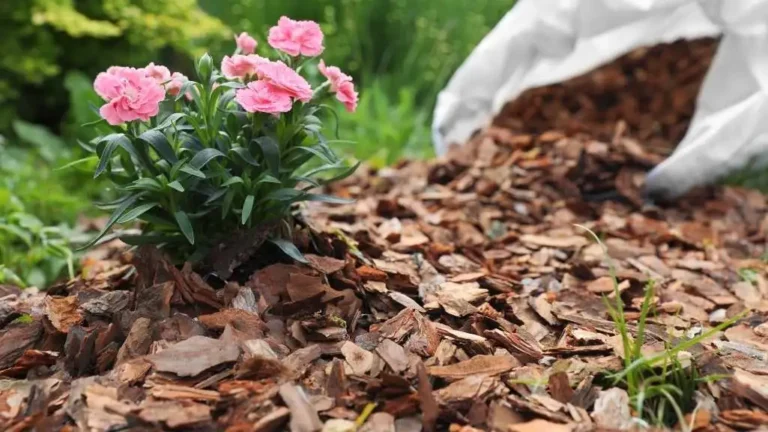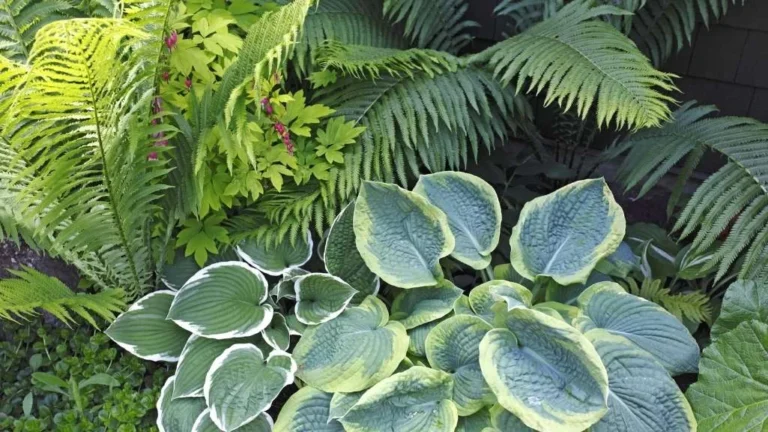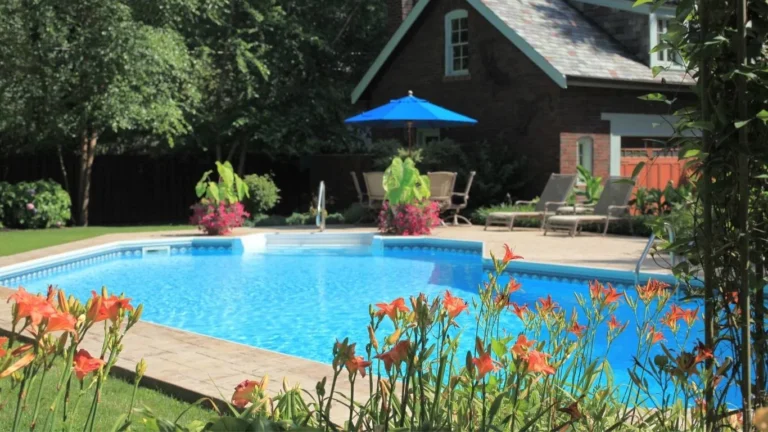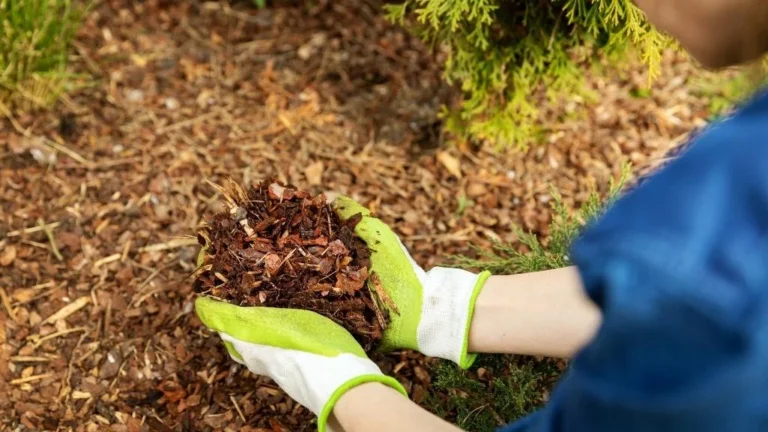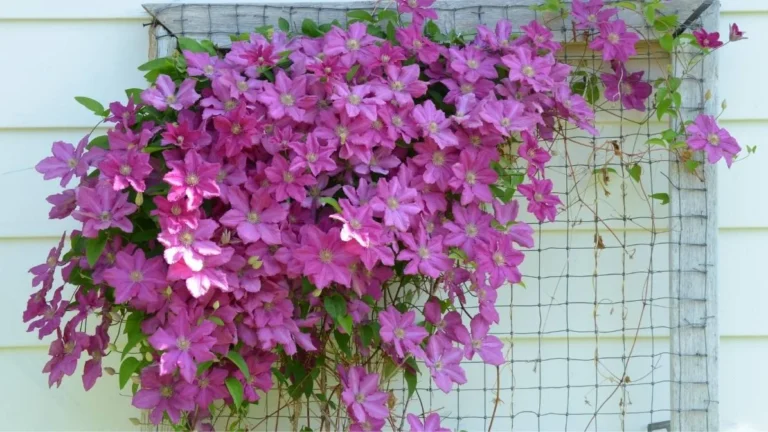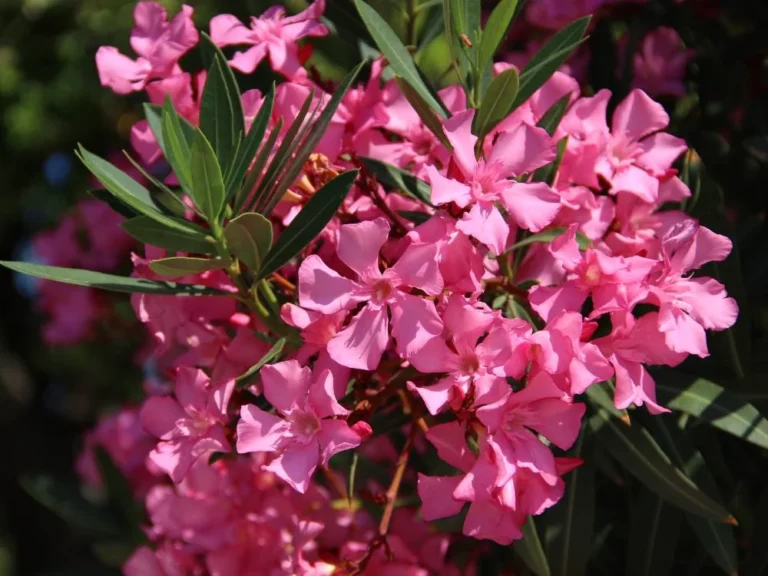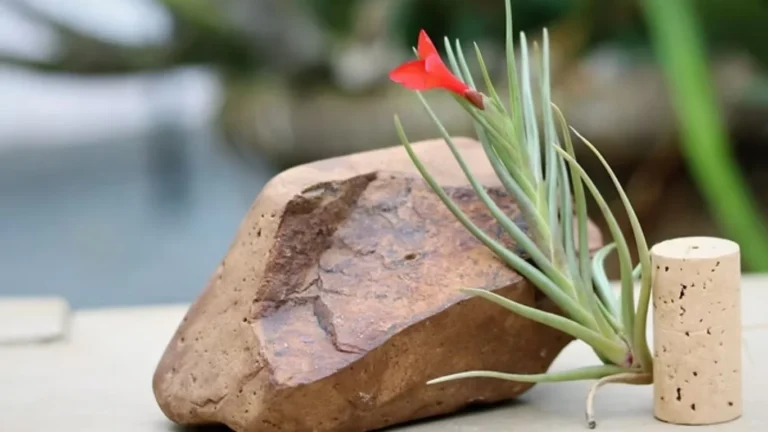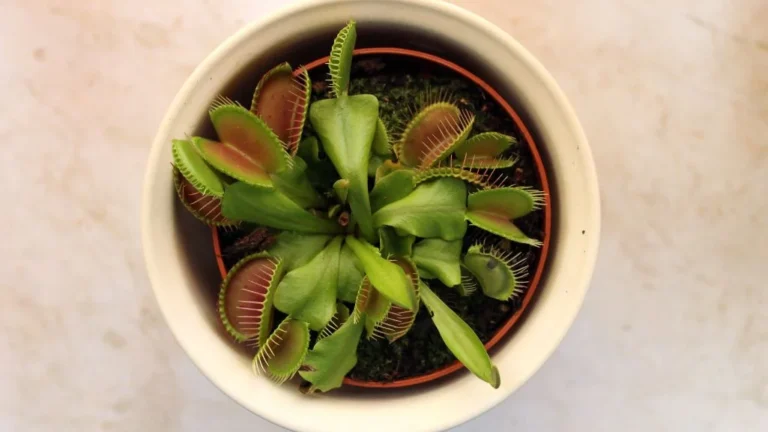Calathea Features
Scientific name | Calathea |
Family | Marantaceae |
Common Names | Prayer plants, Peacock plants, Zebra plants, Rattlesnake plants. |
Native | Tropical rainforests of Central and South America |
Hardiness Zone | USDA Zones 10 to 12 |
Plant Type | Perennial |
Bloom | Rarely |
Appearance
Leaves
Calathea leaves are broad, oval, or lance-shaped, with smooth edges. They come in vibrant colors and patterns like bold stripes, veining, or mottled designs in green, purple, pink, and white shades.
Stem
Calathea stems are not as attractive as their leaves. They are thin and stand in an upright position while holding the leaves.
Height
Prayer plants vary in height depending on the species and cultivar. Typically, they grow around 1 foot to 2 feet. The height of a Calathea plant can also be influenced by its growing conditions, with optimal care often resulting in more vigorous growth.
Types of Calathea
Some commonly seen calathea varieties are Calathea orbifolia, Calathea medallion, Calathea zebrine, Calathea lancifolia (Rattlesnake plant), Calathea roseopicta (Rose-painted Calathea), Calathea makoyana (Peacock plant), Calathea ornata (Pinstripe Calathea), Calathea warscewiczii (Jungle velvet Calathea), Calathea rufibarba (Velvet Calathea), Calathea crocata (Eternal flame Calathea)
Growing Conditions
Requirements for calathea at a glance
Elements | Requirement |
Sunlight | Bright indirect sunlight |
Temperature | 65°F to 80°F |
Humidity | 50-70% |
Soil pH | 6.0-6.5 |
Soil mixture | Moist and well-drained |
Container | Container with drainage hole |
Water | Keep the soil moist consistently. |
Fertilizer | Once a month during summer and spring |
Note: The soil pH level indicates how acidic or neutral the soil is. On a scale of 1 to 10, with 7 indicating neutrality, a pH value less than 7 indicates acidity, while a value greater than 7 indicates alkalinity. Prayer plants require slightly acidic soil.
Soil Mixture
Calathea plants prefer a well-draining potting mix that retains some moisture but doesn’t become waterlogged. It also requires nutrition-rich soil. So, the ideal soil mix for Calathea includes the following components.
- Peat moss or coco-peat holds moisture and improves drainage.
- Pumice or perlite for good drainage and aeration, and
- Compost in a small amount to add nutritional value.
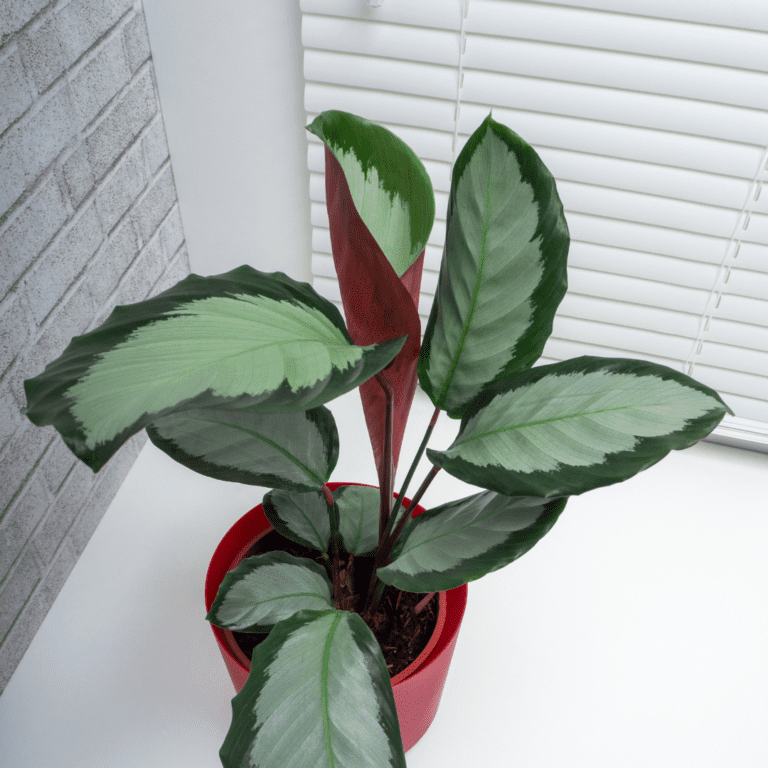
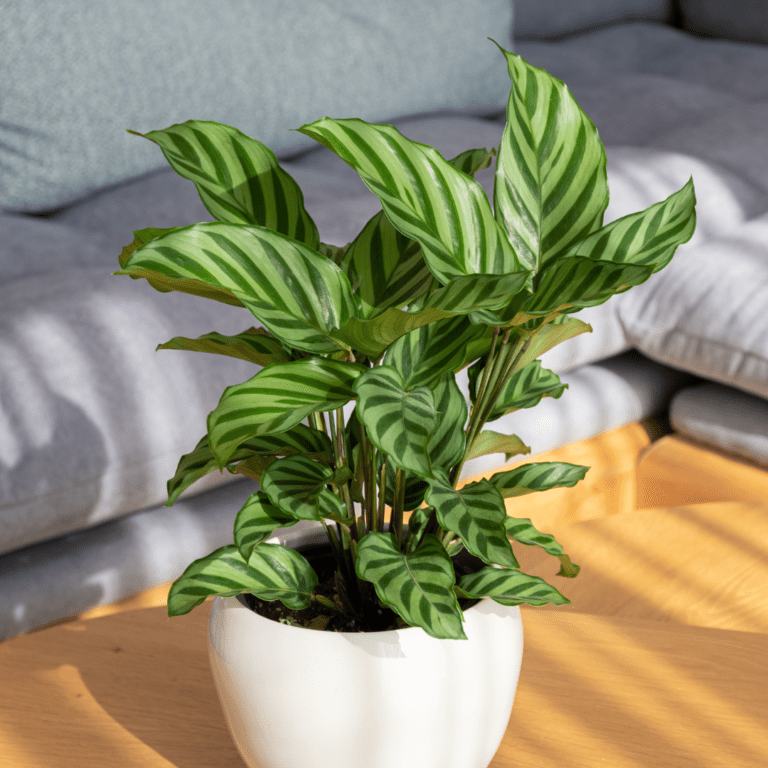
Container
Calathea plants have shallow, fibrous roots spreading horizontally below the soil surface. So, when choosing a container for calathea, consider the following factors.
- The size of the container/pot should be 1-2 inches bigger than the current root system.
- Prayer plants have thin, fibrous roots that can quickly rot if they stay in water too long. So, ensuring the plant doesn’t sit in water is crucial. So, the container must have drainage holes.
- Containers made of ceramic, plastic, or terracotta are suitable for Calathea plants. It’s important to note that plastic pots retain more moisture compared to ceramic or terracotta pots. This difference affects how often you need to water the plant.
Sunlight
Prayer plants require medium to bright, indirect light. Keep them in a place where it get enough light throughout the day. Avoid placing it under direct sunlight; direct sunlight can burn the leaves. So, keeping them in a spot where the light is filtered or diffused is best. Calathea also doesn’t like to be in low-light conditions.
Water
Prayer plant requires consistently moist soil but doesn’t like to be waterlogged. Remember the following things while watering calathea.
- Water the plant when the top layer of the soil dries out. Do a finger dip test or use a moisture meter to check the soil’s moisture level.
- Calathea is sensitive to fluoride and chlorine and may be contained in regular tap water. Use rainwater, filtered, or distilled water.
- While watering, make sure every layer of soil absorbs water. Keep watering until water starts flowing out of the drainage holes at the bottom of the pot.
- Allow excess water to drain away completely, and never let the plant sit in water for prolonged periods.
- Prayer plants need much humidity, so regularly spraying their leaves with water is essential. If the humidity goes below 30%, installing a humidifier to maintain a consistent humid environment is necessary.
Fertilizer
Calathea is a fast-growing plant. So, it requires fertilizer too often. During its growing time (summer and spring), fertilize the plant with a nitrogen-based water-soluble fertilizer once a month. It’s better not to put fertilizer in during winter as prayer plants go into dormancy in winter. Calathea roots are susceptible, so dilute the fertilizer to half its strength before putting it on the soil.
Re-potting
Calatheas should be repotted when their roots become crowded in the pot, typically every 1-2 years. Usually, this plant likes to be root-bound, so check for signs that a calathea needs repotting, including roots growing out of the drainage holes, the plant becoming unstable in its current pot, or water draining too quickly through the soil.
- Calathea’s roots are susceptible, so make sure any roots get damaged while repotting. Don’t remove the soil around the roots. Get the plant out of the container and place it in the new container.
- Use a container that is one size bigger than the current one.
- Repot in spring or early summer, during the growing season. Avoid repotting during the dormant winter months.
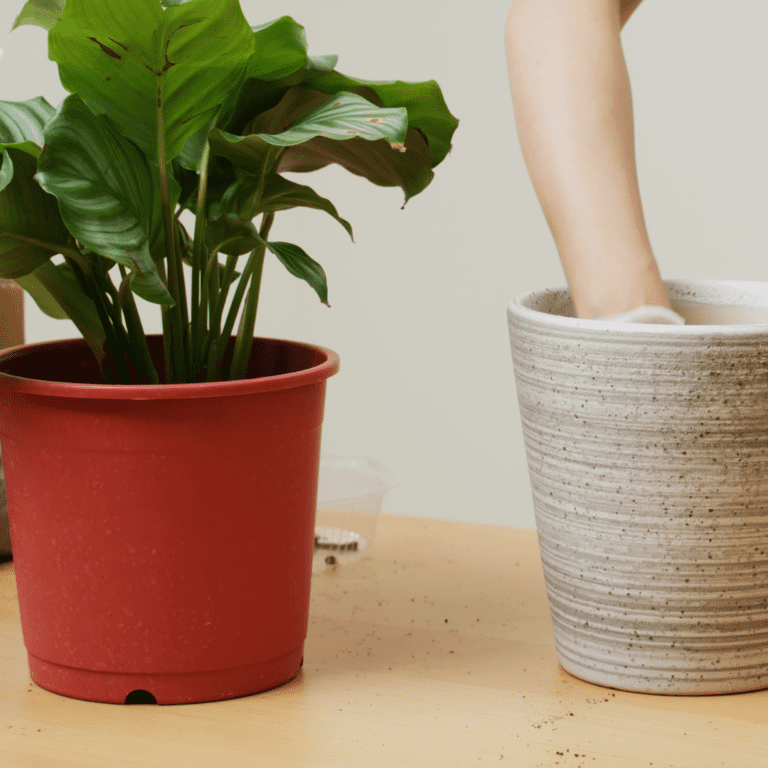
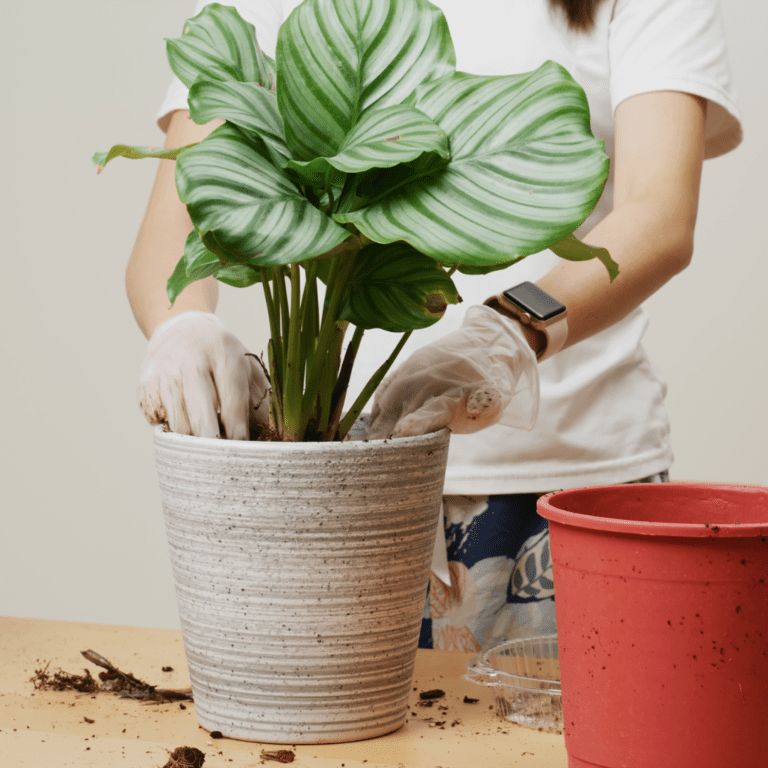
Pruning
Regular pruning helps to make the calathea plant tidy and encourages healthy growth. As this is a high-maintenance plant, its leaves dry out often. Prune calathea as needed throughout the year, removing dead, yellow, or damaged leaves whenever they appear. There’s no specific season for pruning, so trim away any unhealthy foliage whenever it’s noticed.
Pest
Calatheas are sometimes susceptible to pests like spider mites, mealy bugs, and scale insects.
- Regularly check the plant for signs of these pests, such as webs, tiny insects, or sticky residue on the leaves.
- After encountering any pest, isolate the plant immediately.
- Remove the pest by gently washing the leaves with water or wiping the leaves with damp fabric.
- Natural remedies like neem oil or insecticidal soap can control pest populations without harming the plant. Repeat treatments as necessary until pests are eradicated.
- To prevent future infestations, maintain good plant hygiene and avoid overwatering or overcrowding, as pests are often attracted to stress plants.
Other Common Issues
- Leave curling is a sign of under-watering. While the plant is not getting enough water, in that time, the plant curls up its leaves to save moisture. In a case, he just was moist but not soggy. Low humidity can also cause leaf curling. In that case, place the plant in a humid place. Or set up a humidifier. The plant also curls up its leaves when kept under excessive direct sunlight for a long time.
- Crispy leaf tips are also a sign of under-watering.
- Brown leaf tip indicates improper watering, low humidity, direct sun exposure, or minimal building up. Adjust the watering routine, and keep the plant in a humid place where it gets indirect bright light. Use rainwater/distilled/filtered water for watering to prevent mineral build-up.
- Losing leaf patterns occurs when the plant is kept under direct sunlight for a long time. On the other hand, if the plant is kept in low light, the leaf turns green gradually. So, keep the plant in a plant where it gets indirect bright sunlight.
- Leaf patterns can also be lost because of low nutritional value in the soil. Use a water-soluble nitrogen-based fertilizer once a month during summer and spring.
- Droopy leaves are a sign of under-watering. Constantly water the plant when the top layer of the soil dries out.
Propagation
Calathea plant can be propagated by division. The process of propagating calathea is following.
- Choose a healthy, bushy mother plant with several stems.
- Prepare a new pot with drainage holes under it and well-draining soil.
- Gently remove the plant from the existing container without harming the roots.
- Carefully separate the roots to divide the plant into smaller sections, ensuring each part has roots and healthy leaves.
- Place each divided section in its pot, ensuring the roots are covered with soil and the plant is firmly positioned.
- Thoroughly water the newly potted saplings and put them in a warm, humid spot with indirect sunlight.
- Keep the soil consistently moist while the new prayer plants take root and grow.
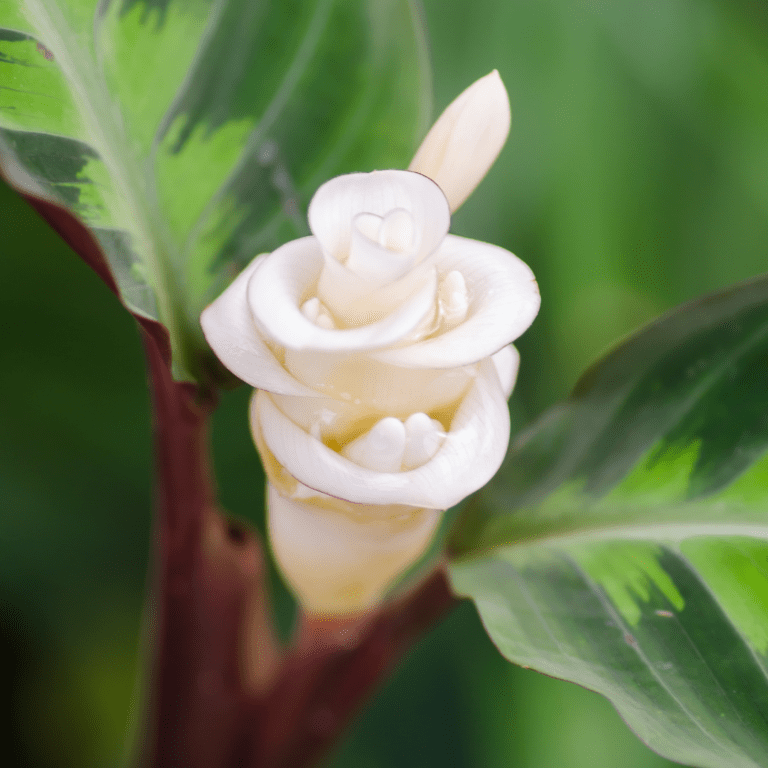

Tips for Calathea
- Put the prayer plants near other houseplants. When plants breathe, they release water into the air. This makes the air around them more humid and suitable for calatheas.
- Once a month, wipe both sides of the leaves with a damp cloth.



